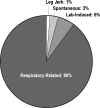Prospective assessment of nocturnal awakenings in a case series of treatment-seeking chronic insomnia patients: a pilot study of subjective and objective causes
- PMID: 23204611
- PMCID: PMC3490361
- DOI: 10.5665/sleep.2244
Prospective assessment of nocturnal awakenings in a case series of treatment-seeking chronic insomnia patients: a pilot study of subjective and objective causes
Abstract
Background: The cause of nocturnal awakenings in patients with chronic insomnia is rarely researched. This study prospectively assessed the etiology of nocturnal awakenings (subjectively and objectively) among patients with insomnia at a private, community-based sleep medical center.
Methods: Twenty adult patients with chronic insomnia enrolled between April 2008 and February 2010 met diagnostic criteria for an insomnia disorder, never previously visited a sleep specialist or underwent sleep testing, and reported no classic sleep disordered breathing symptoms. Patients completed validated scales for insomnia, sleepiness, impairment, anxiety, depression, and quality of life, a qualitative interview to assess subjective reasons for awakenings, and a diagnostic sleep study to objectively assess awakenings and their precipitants.
Results: Subjective and objective data showed clinically meaningful insomnia, primarily sleep maintenance insomnia. The most common self-reported reasons for awakenings were: uncertain cause (50%), nightmares (45%), nocturia (35%), bedroom distractions (20%), or pain (15%). No patient identified breathing symptoms as a cause. Objectively, 531 awakenings were observed in the total sample, and 478 (90%) were preceded by sleep breathing events (apnea, hypopnea, or respiratory effort-related event). Fifty-three awakenings were caused by other factors (independent leg jerks [7], spontaneous [14], and sleep that was laboratory-induced [32]). Thirty awakenings ≥ 5 min-a duration sufficient to predispose toward an insomnia episode-were each preceded by a breathing event.
Conclusions: Among patients with insomnia with no classic sleep breathing symptoms and therefore low probability of a sleep breathing disorder, most of their awakenings were precipitated by a medical condition (sleep disordered breathing), which contrasted sharply with their perceptions about their awakenings
Figures


Comment in
-
Is insomnia a breathing disorder?Sleep. 2012 Dec 1;35(12):1589-90. doi: 10.5665/sleep.2222. Sleep. 2012. PMID: 23204600 Free PMC article. No abstract available.
Similar articles
-
Pharmacotherapeutic failure in a large cohort of patients with insomnia presenting to a sleep medicine center and laboratory: subjective pretest predictions and objective diagnoses.Mayo Clin Proc. 2014 Dec;89(12):1608-20. doi: 10.1016/j.mayocp.2014.04.032. Epub 2014 Sep 15. Mayo Clin Proc. 2014. PMID: 25236429
-
Nocturia. A rarely recognized symptom of sleep apnea and other occult sleep disorders.Arch Intern Med. 1996 Mar 11;156(5):545-50. doi: 10.1001/archinte.156.5.545. Arch Intern Med. 1996. PMID: 8604961
-
Insomnia complaints in patients evaluated for obstructive sleep apnea.Sleep Breath. 2005 Sep;9(3):104-10. doi: 10.1007/s11325-005-0026-x. Sleep Breath. 2005. PMID: 16091954
-
[Etiology of adult insomnia].Encephale. 2002 Nov-Dec;28(6 Pt 1):493-502. Encephale. 2002. PMID: 12506261 Review. French.
-
Comorbid Insomnia and Sleep Apnea: mechanisms and implications of an underrecognized and misinterpreted sleep disorder.Sleep Med. 2021 Aug;84:283-288. doi: 10.1016/j.sleep.2021.05.043. Epub 2021 Jun 8. Sleep Med. 2021. PMID: 34214960 Review.
Cited by
-
Comorbid insomnia and sleep disordered breathing.Curr Treat Options Neurol. 2013 Dec;15(6):692-703. doi: 10.1007/s11940-013-0259-0. Curr Treat Options Neurol. 2013. PMID: 24155146
-
Comorbid insomnia and sleep apnea: a prevalent but overlooked disorder.Sleep Breath. 2018 Mar;22(1):1-3. doi: 10.1007/s11325-018-1628-4. Epub 2018 Jan 25. Sleep Breath. 2018. PMID: 29372382 No abstract available.
-
Characterization of Patients Who Present With Insomnia: Is There Room for a Symptom Cluster-Based Approach?J Clin Sleep Med. 2017 Jul 15;13(7):911-921. doi: 10.5664/jcsm.6666. J Clin Sleep Med. 2017. PMID: 28633722 Free PMC article.
-
Investigating Sleep Disorders among Patients Suffering from Pulmonary Arterial Hypertension.Tanaffos. 2024 Mar;23(3):256-265. Tanaffos. 2024. PMID: 40704339 Free PMC article.
-
Is insomnia a breathing disorder?Sleep. 2012 Dec 1;35(12):1589-90. doi: 10.5665/sleep.2222. Sleep. 2012. PMID: 23204600 Free PMC article. No abstract available.
References
-
- Ohayon MM. Epidemiology of insomnia: what we know and what we still need to learn. Sleep Med Rev. 2002;6:97–111. - PubMed
-
- Ohayon MM. Nocturnal awakenings and comorbid disorders in the American general population. J Psychiatr Res. 2008;43:48–54. - PubMed
-
- Ohayon MM, Zulley J. Correlates of global sleep dissatisfaction in the German population. Sleep. 2001;24:780–7. - PubMed
-
- Ancoli-Israel S, Roth T. Characteristics of insomnia in the United States: results of the 1991 National Sleep Foundation Survey I. Sleep. 1999;22:S347–53. - PubMed
Publication types
MeSH terms
LinkOut - more resources
Full Text Sources
Medical
Miscellaneous

